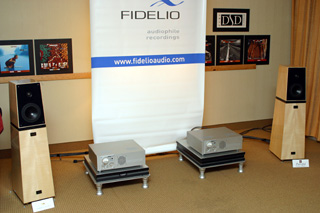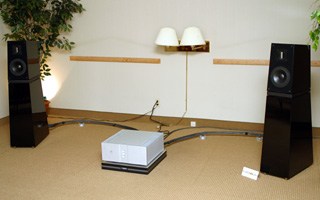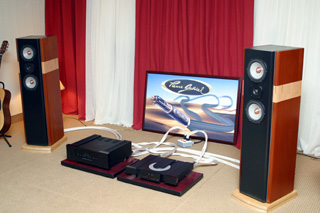 |
||||
| May 15, 2004 Searching for the Extreme: Le Festival Son & Image 2004 In 2003, I attended my first Consumer Electronics Show in Las Vegas. While I was wowed by the scope and scale of CES, my most lasting memory was of the intensity on the faces of those junior Calvinists with whom I shared the redeye flight to Sin City. The air on that plane was thick with ambition -- each one of those movers and shakers, sitting there with headphones piping in motivational speeches, was going to make the big deal. I could almost see the thought bubbles over their heads: "This is going to be my year!"Now contrast CES’s carpe diem fervor to the laissez-faire breeziness at this year’s Le Festival Son & Image, held April 2-4 in Montreal, Canada. While there were some definite keeners among the exhibitors, many were so laid-back they seemed almost tranquilized. Although it does have a trade element, Son & Image is, foremost, an enthusiast’s show, and because there were no empires at stake, everyone was calm, friendly, and willing to talk. The show is split between two venues, the Hotel Delta and the Sheraton Four Points, in downtown Montreal. Because the Delta hosts the majority of the rooms, I always begin my tour there. I feel a sense of urgency at the beginning of a show -- as I get my press pass before the public gets a chance to pay, I can zip to the top of the hotel and scamper from room to room in relative solitude, a tidal wave of audiophiles hot on my heels. The downside of my bright-eyed enthusiasm was that I was early -- some of the rooms on the top floor weren’t open yet. I imagined bleary-eyed exhibitors rolling over and pressing the Power buttons on their gear before climbing out of their sleeping bags, fully dressed, and opening the door to greet visitors. One of the first open rooms I visited was radiating significant low frequencies, which always draws me in without fail. (My wife is convinced it’s a prostate thing; she feels no such compulsion.) "That’s interesting," thought I. "Sounds like a killer sub." Not so. Instead, I discovered Mike Vince of StudioLAB looking smug, and with good reason. His new Reference Protégés were hammering out Dead Can Dance’s Into the Labyrinth with significant authority, and using only two 4" woofers in each slim, elegant pillar to do so. Both of these diminutive drivers run full-range in the bass -- you can see the little buggers flailing away, making up in extension for what they lack in diameter. Aided by a Vifa tweeter, the sound was warm, detailed, and enveloping. At only $1950/pair (all prices in Canadian dollars unless otherwise stated), rising to $2600/pair in bird’s-eye maple, these little guys have bargain written all over them. The rest of the system was just as juicy, consisting of Korato tube monoblocks ($5000/pair) and tube preamp ($3900), and fronted by a Musical Fidelity Tri-Vista SACD player. There was no wall of 15" subs venting in from the bathroom. I checked.
My first planned stop was the Fidelio Audio room, where astonishing sound met wretched excess. Fidelio is a record label that specializes in minimalist recordings made with the best possible care and the best possible equipment. Their releases are available on dual-layer SACDs, many of them in multichannel format. This year, Fidelio’s system consisted of two pairs of Verity Parsifals ($18,995/pair USD in premium finish), each powered by its own Nagra amplifier: MPA solid-state monoblocks ($48,000/pair) for the front channels, VPA tube monoblocks ($20,000/pair) for the surrounds. The concept of surround amplifiers that cost almost as much as my entire system made me giggle. The results, though, were nothing to laugh at. I sat down to a choral piece that was accompanied by what sounded like an organ with 100’ pipes. The sense of the acoustic in which the piece was recorded was absolutely spooky. "Now I will turn off the surround channels," lilted René Laflamme in his outrageous French accent. Suddenly, the hall collapsed into a mid-priced hotel room with the beds removed. He switched the surround channels back in, and the church reappeared and the hairs on the back of my neck stood up. The subtlety with which the surround track was presented, along with its modest (almost inaudible) volume, combined to produce the most realistic and impressive multichannel music demo I’ve yet experienced.
The new Thorens TD850 turntable ($2995 with RB300 tonearm) wins the Ultra Audio Density Award hands down. With a thick slab of stainless steel running through its middle, the TD850 feels more like a 45-pound Olympic weight-training plate than a turntable. The eager young gentleman in the Unico room was happy to tell me how good this baby sounded, but unfortunately he wasn’t able to place it on the equipment rack for fear that the sharp cones on the bottom of the turntable would damage the rack’s surface. I made change for a dollar, and we carefully set the ’table down on three quarters (heads up for best sound) so that we could have a listen. Fronted by the Clearaudio Aurum Classics Wood cartridge ($250) and backed up by the new Unico P ($1696) -- the Unico’s little brother but with less power and an obviously competent phono stage -- and presented by the Opera Platea speakers ($2595/pair), the sound was dynamic and exceptionally rhythmic.
After a delightful cafeteria-style lunch and lots of insider gossip with Doug Schneider, Marc Mickelson, and music reviewer extraordinaire John Crossett, I found myself facing Verity Audio’s new Sarastro speaker ($40,000/pair). This serious piece of audio gear easily won the staring contest, and I meekly took a seat. There’s much to admire in the Sarastro; with a ribbon tweeter and rear-facing 12" bass driver, it projects solidity and freakishly high build quality before it even plays a note. Powered by an Ayre V-1x amplifier and fed by an Ayre K-1x preamp and a tasty dCS Purcell-Elgar-Verdi digital stack, the Sarastros backed up their looks with dynamic, effortless bass and a treble that was silky and slightly more detailed than I’ve noted from Verity’s cheaper (!) speakers. Diamond Groove’s vinyl booth was a swell interlude, placed as it was right in the middle of the Hotel Delta instead of in a kiosk in the lobby. They were selling LPs hand over fist, their tricksy location being the equivalent of ladling out chum in shark-infested waters. I picked up a great-sounding Classic Records reissue of CSNY’s Déjà Vu, but otherwise exercised admirable restraint. On my second pass through the Delta, I rolled up my sleeves and elbowed my way into the tight confines of the Simaudio-Dynaudio grotto. Despite the crowds, I was determined to get in -- I could hear a cut from Bill Frisell's Gone, Just Like a Train, which is one of my favorite albums. The close quarters were due to the ceiling-high racks of Simaudio products in front of the black curtains that lined the walls, leaving a little mail slot within which to maneuver. The Dynaudio Confidence C2s ($12,000/pair), set up for nearfield listening, sounded detailed, clean, and edge-free. Simaudio’s new Moon W-5 LE limited-edition amplifier ($7800) provided the motivation, fed by the P-5 LE preamplifier ($6750) and Eclipse LE CD player ($9500), while Cardas Golden Cross cables snaked seductively across the floor to connect all components. Although Simaudio plans to make only 250 of each LE component, they’re producing LE versions of all their other Moon-series products, so there should be enough to go around. Down on the second floor, I passed the same calm, unflappable gentleman who had been standing, sentinel-like, outside of the Pierre Gabriel-Jadis room for the past four years. His friendly, world-weary nod guided me in. Every year, the sound produced by the Pierre Gabriel speakers impresses me to no end, and this year I can tell everyone about it. This time, Pierre Gabriel himself took the time to elaborate on the makeup of the systems in both their rooms. I asked him which room he was most proud of and would like me to feature. "Both of them," he deadpanned, giving me his best French gangster staredown.
Right, then. In the tube-powered room, the Jadis DA60 integrated amplifier ($12,000 in Inox Lux finish) received its signals from a Jadis JD3 Drive CD player ($6000). The speakers were the Pierre Gabriel Master References ($25,000/pair), sounding sweet and unfatiguing, with superb soundstaging. Next door, in the solid-state suite, the Gryphon Callisto 2200 integrated amplifier ($12,000), which spits out a hot 200Wpc, drove the Pierre Gabriel Master speakers ($15,000/pair) to good effect. The source here was the Gryphon Mikado CD player ($15,000), which features the slickest top-loading bay I’ve ever seen: After the lid opens upward, the bay lights up with a ring of blue LEDs that encircle the CD. I half expected the CD to levitate, spinning all the while, and land in the jewel case I was holding open. Most cool. Late Saturday afternoon, all tuckered out after a long day of listening to the world’s best audio systems (feel my pain), I retired to our room for my afternoon nap. Suitably refreshed, Kim and I strode forth to Moishe’s Steak House for what is quite possibly the world’s best steak. This 12-ounce filet is close to 2" thick and is broiled without seasonings, yet is astonishingly delicious. It’s like eating velvet. If you’re ever in Montreal, I insist that you visit this restaurant and experience its fantastic food and impeccable service. I'm already looking forward to next year. ...Jason Thorpe
Ultra Audio is part of the SoundStage! Network. |



